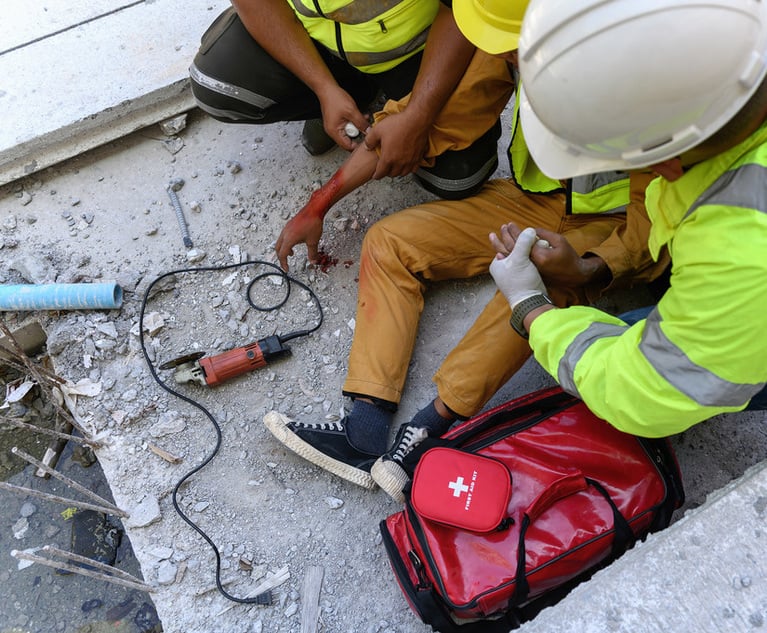Adding Value, Reducing Risk: Peer Review for Construction Projects
A "second set of eyes" will provide an assessment of whether the designer's plans and drawings will result in a building that conforms to all applicable codes and is safe.
December 13, 2019 at 10:30 AM
7 minute read
 suphakit73
suphakit73
In the aftermath of recent construction disasters leading to catastrophic failures and loss of life, the concept of peer review has taken on an entirely new significance. A comprehensive plan and specification peer review is an effective risk management strategy for ensuring quality construction. Indeed, the National Transportation Safety Board concluded in its October 2019 report that inadequate peer review was a contributing factor in the fatal pedestrian bridge collapse at Florida International University in March 2018.
What Is Peer Review?
Peer review is a process by which independent designers examine a construction project's design. A "second set of eyes" will provide an assessment of whether the designer's plans and drawings will result in a building that conforms to all applicable codes and is safe. The review will identify areas where the design is incomplete or contains errors, and assesses whether the design is feasible to build. Peer reviews may be used for quality assurance, risk management, cost and/or code compliance.
Some jurisdictions require peer review for projects that exceed certain threshold limitations such as height, volume or number of occupants. Others require them for unusually complicated designs, and some offer an accelerated permit process where there has been voluntary peer review.
How Is Peer Review Done?
To begin, an owner identifies an independent designer with comparable expertise and experience to the designer of record for the project. The independent designer can be engaged from a different design firm, or can be from the same firm, so long as she or he was not involved in the original design and has the appropriate expertise.
A peer reviewer is a neutral party, there should be no adversity between the peer reviewer and the designer. The peer reviewer's role is not to criticize, but to enhance the design, and the peer review process should be approached as a learning opportunity. The most effective reviews occur when the reviewing designer performs an independent analysis of the structure and then constructively communicates any concerns, questions or discrepancies to the designer of record.
Involving a peer reviewer from the earliest possible stage of the design process may be most effective. Sometimes project developers retain a peer review consultant at the same time as they engage the project designer. Often, a developer will require that a design firm include an experienced peer reviewer as part of their project team. This approach allows the peer reviewer to collaborate with the designer to ensure that there are no major engineering mistakes or issues overlooked.
While peer review can be done after the design is complete, in the event errors are discovered or issues arise, corrections and changes often lead to increased costs and delays in everything from project approvals to construction time. As such, after-the-fact review is much less desirable.
The peer reviewer's first step is to examine the drafts of the design drawings and specifications and to confirm that the design meets the local construction and building codes. The peer reviewer should not assume that the designer's work is accurate, because that assumption undercuts the very role of the peer reviewer, which is to determine if the work is correct. Rather, the peer reviewer should perform independent calculations to demonstrate to his or her satisfaction that the design will perform as intended.
In addition, peer review provides an opportunity for a second set of eyes to evaluate specified equipment and materials. Catching an equipment or materials error or problem at an early stage in the process will save costly delays later should something specified turn out to be inappropriate, unavailable or inefficient.
The next step in the process involves the peer reviewer providing a comprehensive report detailing his or her findings. Those findings are provided as a tool to assist the designer of record in refining the drawings and specifications. It provides the opportunity to make corrections and changes before an error or problem occurs in the field, where it inevitably will result in delays, change orders and extra costs.
Finally, the last step is for the peer reviewer to meet with the design team to work through the identified issues and come up with agreed upon solutions.
Benefits of Peer Review
Peer review provides confirmation and assurance that the design is sound and that the design specifications are clear. A peer reviewed project is that much more likely to quickly and successfully complete permit and code compliance review.
A peer reviewed design may also proceed more quickly than a non-reviewed project as issues that cause delays (errors and omissions in the plans) have already been identified and addressed. Indeed, it may be possible to impose a tighter construction schedule on a project that is peer reviewed.
Moreover, there is greater assurance that materials and equipment will be available and perform as intended. By addressing concerns before construction, a peer review reduces the number of RFIs and change orders, which in turn reduces costs.
The least acknowledged benefit of a peer review is fostering communication between designers, owners and builders. Better communication reduces errors and omissions.
Potential Pitfalls
While the benefits of peer review are multiple, there are also potential problems. For example, if a peer reviewer (for reasons such as time or cost) relies on information or calculations provided by the designer of record rather than doing the analysis independently, the evaluation could fail to capture the precise errors or omissions it is intended to address.
Peer reviews also have the potential to be inefficient and ineffective. Inefficiencies can occur if there is a duplication of effort that is not necessary. Peer review is ineffective where the peer reviewer rubber stamps the original designer's work without independently verifying its accuracy.
Another issue of which to be aware is the relationship between the peer reviewer and owner. If the reviewer has an intent to discredit the original designer in the eyes of the owner so as to obtain an advantage in obtaining future work, the review may show skewed results. On the other hand, if the peer reviewer is motivated to placate the owner, the reviewer may avoid bringing issues and concerns to the owner's attention.
Finally, if the original designer refuses to cooperate with the peer reviewer, the benefits of the process are completely devalued.
Why Isn't Peer Review Required for All Projects?
As mentioned earlier, some jurisdictions offer a streamlined permit and code compliance review process for those projects which have been independently peer reviewed. Others require peer review only for projects of certain dimension. However, peer review remains a primarily voluntary procedure.
This is because there is a cost associated with peer review that not all projects can bear. Also, the time a peer review can take, particularly in the case of complicated designs, may obviate its usefulness. Finally, there are designers whose egos prevent them from taking full advantage of a second level review. Their objections, and assurance to owners that peer review is not necessary, can dissuade owners from engaging peer reviewers.
Conclusion
It is difficult to quantify the benefits of peer review because the benefits accrue primarily in the form of problem avoidance and increased confidence in project performance. However, peer review can provide a great benefit to a construction project by reducing time, cost and error.
Jacqueline Greenberg Vogt is a shareholder with Greenberg Traurig in Florham Park. She concentrates her practice on construction contracting and litigation.
This content has been archived. It is available through our partners, LexisNexis® and Bloomberg Law.
To view this content, please continue to their sites.
Not a Lexis Subscriber?
Subscribe Now
Not a Bloomberg Law Subscriber?
Subscribe Now
NOT FOR REPRINT
© 2025 ALM Global, LLC, All Rights Reserved. Request academic re-use from www.copyright.com. All other uses, submit a request to [email protected]. For more information visit Asset & Logo Licensing.
You Might Like
View All

Dispute Resolution Boards—Getting Real Time Decisions on Construction Projects
7 minute read
Insurer Has No Duty to Defend 'Laidlow' Claims, NJ Supreme Court Says
3 minute read
Construction Worker Hit by Falling Concrete Settles Claims for $2.3M
4 minute readLaw Firms Mentioned
Trending Stories
- 1Reviewing Judge Merchan's Unconditional Discharge
- 2With New Civil Jury Selection Rule, Litigants Should Carefully Weigh Waiver Risks
- 3Young Lawyers Become Old(er) Lawyers
- 4Caught In the In Between: A Legal Roadmap for the Sandwich Generation
- 5Top 10 Developments, Lessons, and Reminders of 2024
Who Got The Work
J. Brugh Lower of Gibbons has entered an appearance for industrial equipment supplier Devco Corporation in a pending trademark infringement lawsuit. The suit, accusing the defendant of selling knock-off Graco products, was filed Dec. 18 in New Jersey District Court by Rivkin Radler on behalf of Graco Inc. and Graco Minnesota. The case, assigned to U.S. District Judge Zahid N. Quraishi, is 3:24-cv-11294, Graco Inc. et al v. Devco Corporation.
Who Got The Work
Rebecca Maller-Stein and Kent A. Yalowitz of Arnold & Porter Kaye Scholer have entered their appearances for Hanaco Venture Capital and its executives, Lior Prosor and David Frankel, in a pending securities lawsuit. The action, filed on Dec. 24 in New York Southern District Court by Zell, Aron & Co. on behalf of Goldeneye Advisors, accuses the defendants of negligently and fraudulently managing the plaintiff's $1 million investment. The case, assigned to U.S. District Judge Vernon S. Broderick, is 1:24-cv-09918, Goldeneye Advisors, LLC v. Hanaco Venture Capital, Ltd. et al.
Who Got The Work
Attorneys from A&O Shearman has stepped in as defense counsel for Toronto-Dominion Bank and other defendants in a pending securities class action. The suit, filed Dec. 11 in New York Southern District Court by Bleichmar Fonti & Auld, accuses the defendants of concealing the bank's 'pervasive' deficiencies in regards to its compliance with the Bank Secrecy Act and the quality of its anti-money laundering controls. The case, assigned to U.S. District Judge Arun Subramanian, is 1:24-cv-09445, Gonzalez v. The Toronto-Dominion Bank et al.
Who Got The Work
Crown Castle International, a Pennsylvania company providing shared communications infrastructure, has turned to Luke D. Wolf of Gordon Rees Scully Mansukhani to fend off a pending breach-of-contract lawsuit. The court action, filed Nov. 25 in Michigan Eastern District Court by Hooper Hathaway PC on behalf of The Town Residences LLC, accuses Crown Castle of failing to transfer approximately $30,000 in utility payments from T-Mobile in breach of a roof-top lease and assignment agreement. The case, assigned to U.S. District Judge Susan K. Declercq, is 2:24-cv-13131, The Town Residences LLC v. T-Mobile US, Inc. et al.
Who Got The Work
Wilfred P. Coronato and Daniel M. Schwartz of McCarter & English have stepped in as defense counsel to Electrolux Home Products Inc. in a pending product liability lawsuit. The court action, filed Nov. 26 in New York Eastern District Court by Poulos Lopiccolo PC and Nagel Rice LLP on behalf of David Stern, alleges that the defendant's refrigerators’ drawers and shelving repeatedly break and fall apart within months after purchase. The case, assigned to U.S. District Judge Joan M. Azrack, is 2:24-cv-08204, Stern v. Electrolux Home Products, Inc.
Featured Firms
Law Offices of Gary Martin Hays & Associates, P.C.
(470) 294-1674
Law Offices of Mark E. Salomone
(857) 444-6468
Smith & Hassler
(713) 739-1250






